Music
Trailers
DailyVideos
India
Pakistan
Afghanistan
Bangladesh
Srilanka
Nepal
Thailand
StockMarket
Business
Technology
Startup
Trending Videos
Coupons
Football
Search
Download App in Playstore
Download App
Best Collections
Technology
Missing out on a monthrent because you can&t find a tenant is a huge loss. Searching for someone to fill a home takes work, while property managers are incentivized to price your place too high, leading to costly vacancies.
But new startup Doorstead wants to take on the risk and the work for you. It acts as a property manager for single-family homes, but guarantees you rent at a specific rate starting in a certain number of days, even if it can&t fill the house or apartment. It also handles all the algorithmic pricing, advertising, tenant interviews, repairs, maintenance, leases and online payments in exchange for 8% of rent. Owners just sit back and receive the money, making it much easier to profit off of distant real estate. The startup claims to earn users 3% to 9% more than other property management models.
Doorstead approach to the hot sector of &iRenting& has attracted a $3.3 million seed round co-led by M13 and Silicon Valley Data Capital, and joined by Venture Reality Fund and SOMA Capital. They&re betting on co-founders Jennifer Bronzo, whose parents ran a construction and property management firm, and Ryan Waliany, who worked in product at Uber after his recipe platform Kitchenbowl was acqui-hired.

Doorstead co-founders (from left): Jennifer Bronzo and Ryan Waliany
&I grew up going to job sites and learning about construction,& Bronzo says. &In the recent decade, my family purchased a lot of properties in the Bay and they needed help filling capacity. I saw so many opportunities in property management because of how antiquated the industry is.& Doorstead is now operating in five cities around the San Francisco Bay Area.
As consumers grow accustomed to zero-friction services, that approach is branching into bigger and bigger sectors like the trillions paid for long-term rentals. Waliany, DoorsteadCEO, tells me, &We&re in the process of Uber&izing each step of the property management life cycle.& The startup is hoping to become the OpenDoor of rentals.
How Doorstead works
 First, property owners contact Doorstead and provide some basic information on the home they want to rent out. They receive a preliminary offer before the startup does an inspection and takes professional marketing photos while digging through reams of data on local pricing, availability and demand to pick a rate its algorithm believes it can fill the home for quickly. Owners then receive a final offer agreement saying they&ll be paid $X per month starting in Y number of days (typically 21 to 45 days), with Doorstead absorbing all the risk if it can&t find a tenant.
First, property owners contact Doorstead and provide some basic information on the home they want to rent out. They receive a preliminary offer before the startup does an inspection and takes professional marketing photos while digging through reams of data on local pricing, availability and demand to pick a rate its algorithm believes it can fill the home for quickly. Owners then receive a final offer agreement saying they&ll be paid $X per month starting in Y number of days (typically 21 to 45 days), with Doorstead absorbing all the risk if it can&t find a tenant.
From there, the startup does approved maintenance and cleaning as necessary, and then methodically lists the home on all the top rental platforms. It handles open house walk-throughs and runs background checks on potential tenants to find who will most reliably pay rent. Doorstead prepares a lease and gets it signed by a tenant, but even if it doesn&t, owners still get their guaranteed payments. Rent is collected online, and if a move-out or eviction is necessary, Doorstead takes care of the transition to finding a new tenant.
Thereplenty of margin for Doorstead to earn if it can consistently fill homes faster. Most property managers charge at least 50% of the first monthrent, but instead, Doorstead keeps all the rent of any extra days if it fills the spot before the guaranteed due date. From there, it charges 8% of monthly rent with no tenant placement fee, which is close to or under the common 10% fee on single-family home property management. And if it manages to secure a higher rate from tenants than its guarantee, it gives 70% to the owner.
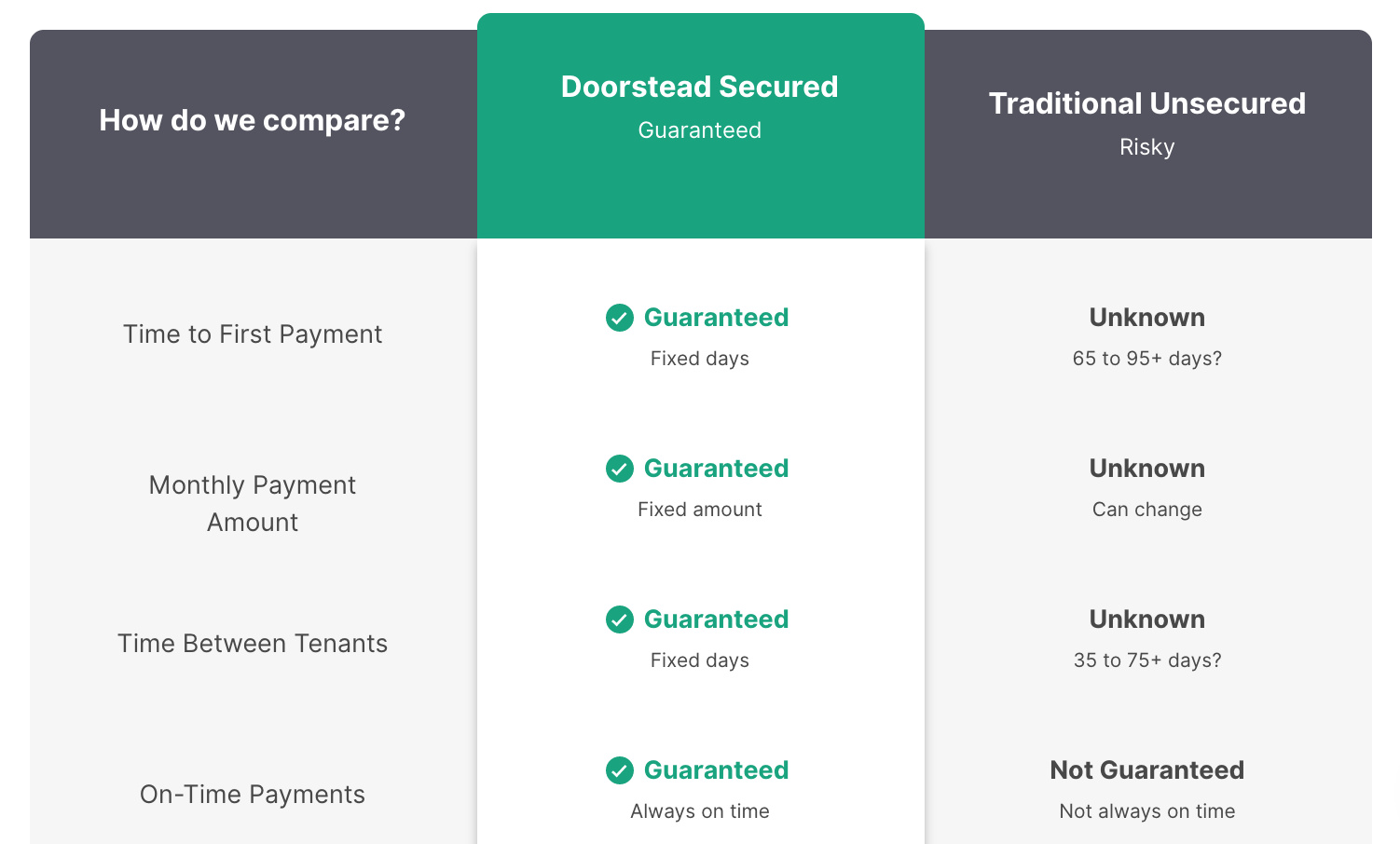
Doorstead claims to be less risky than alternatives
&Property management incumbents have a 43-day vacancy average which leads to $86 billion in economic waste in the U.S. alone,& Waliany tells TechCrunch. &This means that landlords could earn the same money and lower rents by 12% for tenants with an efficient market.&
The rise of iRenting
With Doorstead, even if the owner lives far away, the turn-key service lets them efficiently rent their home. Thatnot only important to them, but to overcrowded cities like San Francisco that often see apartments left vacant by overseas owners because they&re too much effort to rent out. To date, Doorsteadalgorithm has allowed it to recoup 100% of its guarantees and itshooting to stay above 90%, while maintaining its NPS of 80.

But if the startup is working that well, itonly a matter of time until incumbents try to barge in.
&It would be a no brainer for Airbnb to enter this market and Zillow to open this,& Waliany admits, given their existing pricing algorithms and popularity as rental destinations. But Bronzo says &the biggest barrier is the operations piece that an Airbnb and Zillow haven&t stepped into.& It would be a big departure from their lean software-based marketplaces. Other property management startups like Mynd, OneRent and BelongHome only offer guaranteed rent once tenants are found, absolving themselves of most of the risk. They&d have to take on a more precarious business model.
What about Zeus, Sonder and Lyric, which offer property management of homes they then use for corporate housing or as boutique hotels? &An owner of ours considered Zeus versus Doorstead and went with Doorstead because: 1) our offer was ~12% higher, and 2) they didn&t want the wear-and-tear that comes with having people move in and out of the property every few days or few months,& Waliany explains. &Sonder and Lyric have 300 move-in and move-outs over a six-year period. Doorstead has ~4 move ins/outs and that results in significantly less wear-and-tear and a much easier operations to manage. Not only that, the long-term rental market is 42x larger and has 12x more addressable revenue.& Doorstead will have to build a brand and product moat to defend against inevitable direct competition.

As iRenting is still a fresh concept, Waliany warns that &with any new business model, there will inevitably be ‘unknown unknowns& that we cannot predict, black swan events and things that we might only be able to learn through calculated bets.& Luckily, because it doesn&t hold the leases for very long, and home rentals typically increase in an economic downturn, Doorsteadliability is manageable in the event of a recession or other crisis.
&There are three large trillion-dollar industries — food, transportation and housing. At Doorstead, we have an opportunity to completely redefine the housing value chain by creating a new class of property management that eliminates unnecessary vacancies. In the end, this redefinition of the value chain allows ourselves to become the Blackstone of the future,& Waliany concludes. &It seems like we&re giving everyone free money.& That will prove either the startupdownfall or a powerful growth tactic.
- Details
- Category: Technology
Read more: Get guaranteed rent for your home from new startup Doorstead
Write comment (94 Comments)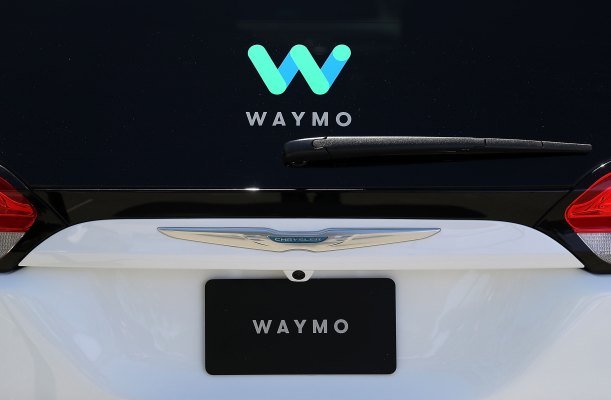
Waymo, the autonomous vehicle company under Alphabet, has started creating 3D maps in some heavily trafficked sections of Los Angeles to better understand congestion there and determine if its self-driving vehicles would be a good fit in the city.
For now, Waymo is bringing just three of its self-driving Chrysler Pacifica minivans to Los Angeles to map downtown and a section of Wilshire Boulevard known as Miracle Mile.
Waymo employees will initially drive the vehicles to create 3D maps of the city. These maps are unlike Google Maps or Waze. Instead, they include topographical features such as lane merges, shared turn lanes and curb heights, as well as road types and the distance and dimensions of the road itself, according to Waymo. That data is combined with traffic control information like signs, the lengths of crosswalks and the locations of traffic lights.
Waymo does have a permit to test autonomous vehicles in California and could theoretically deploy its fleet in Los Angeles. But for now, the company is in mapping and assessment mode. Waymoforay into Los Angeles is designed to give the company insight into driving conditions there and how its AV technology might someday be used.
The company said it doesn&t plan to launch a rider program like its Waymo One currently operating in the suburbs of Phoenix. Waymo One allows individuals to hail a ride in one of the self-driving cars, which have a human safety driver behind the wheel.
The self-driving car company began testing its autonomous vehicles in and around Mountain View, Calif., before branching out to other cities — and climates — including Novi, Mich., Kirkland, Wash., San Francisco and, more recently, in Florida. But the bulk of the companyactivities have been in the suburbs of Phoenixand around Mountain View — two places with lots of sun, and even blowing dust, in the case of Phoenix.
- Details
- Category: Technology
Read more: Waymo is creating 3D maps of Los Angeles to better understand traffic congestion
Write comment (97 Comments)Income share agreements (ISAs) rose to public awareness this year — if measured in press articles and discussion on &VC Twitter& — after several years of niche experimentation among a small community of education advocates. An ISA in a financing model where the student participates in an education program without paying tuition, then pays a certain percentage of their income for a set period of time in return.
As I mentioned in my analysis of ISAs back in April, there is rapid growth in ISA pilots by traditional universities in the US and by vocational training programs but therealso a lot of regulatory uncertainty. This isn&t a scenario where private sector leaders are seeking less regulation and activists wanting more: private sector leaders are actively lobbying more regulation so there are protections against discrimination and predatory behavior — many fear one bad actor ruining the reputation of the entire movement — and are seeking legal clarity on a range of issues like the tax implications of an ISA on all parties involved.
The ISA Student Protection Act is currently making its way through Congress with bipartisan sponsorship from Senators Todd Young (R-IN), Marco Rubio (R-FL), Mark Warner (D-VA), and Chris Coons (D-DE). The Department of EducationDiane Auer Jones said the department is planning to pilot an ISA program, to which Senator Elizabeth Warren issued a letter demanding detailed explanation of the plan and the potential negative impacts.
I asked several of the entrepreneurs, investors, and policy experts at the forefront of ISAs to share their perspectives on the current state of the ISA movement:
- Tonio DeSorrento, Vemo Education
- Ethan Pollack, Aspen Institute
- Shaan Hathiramani, Flockjay
- Austen Allred, Lambda School
- Alison Griffin, Whiteboard Advisors
- Sam Lessin, Slow Capital
- Terri Burns, GV
- Kristen Sharp, Entangled Solutions
- Leo Polovets, Susa Ventures
- Jan Lynn-Matern, Emerge Education
Herewhat they had to say…

Image via Getty Images / manopjk
Tonio DeSorrento, Founder - CEO of Vemo Education
&Whatbeen really fascinating, in recent years, is the innovation that is occurring at colleges and universities that are using ISAs to support and improve student success.
- Details
- Category: Technology
Read more: Checking in on the state of ISAs
Write comment (94 Comments)In a long-awaited move, Spotify announced this morning its iOS 13 app would now offer Siri support and its streaming music service would also become available on Apple TV. That means you can now request your favorite music or podcasts using Siri voice commands, by preferencing the command with &Hey Siri, play…,& followed by the audio you want and concluding the command with &on Spotify.&
The Siri support had been spotted earlier while in beta testing, but the company hadn&t confirmed when it would be publicly available.
According to Spotify, the Siri support will also work over Apple AirPods, on CarPlay and via AirPlay on Apple HomePod.
In addition, the Spotify iOS app update will include support for iPhonenew data-saver mode, which aids when bandwidth is an issue.
Spotify is also today launching on Apple TV, joining other Spotify apps for TV platforms, including Roku, Android TV, Samsung Tizen and Amazon Fire TV.
The app updates are still rolling out, so you may need to wait to take advantage of the Apple TV support and other new features.
The lack of Siri support for Spotify was not the streaming music servicefault — it wasn&t until iOS 13 that such support even became an option. With the new mobile operating system launched in September, Apple finally opened up its SiriKit framework to third-party apps, allowing end-users to better control their apps using voice commands. That includes audio playback on music services like Spotify, as well as the ability to like and dislike tracks, skip or go to the next song and get track information.
Pandora, Google Maps and Waze were among the first to adopt Siri integration when it became available in iOS 13 — a clear indication that some of Applechief rivals have been ready and willing to launch Siri support as soon as it was possible.
Though the integration with Siri will be useful for end-users and beneficial to Spotifybusiness, it may also weaken the streaming companyantitrust claims against Apple.
Spotify has long stated that Apple engages in anti-competitive business practices when it comes to its app platform, which is designed to favor its own apps and services, like Apple Music, it says. Among its chief complaints was the inability of third-party apps to work with Siri, which gave Appleown apps a favored position. Spotify also strongly believes the 30% revenue share required by the App Store hampers its growth potential.
The streamer filed an antitrust complaint against Apple in the European Union in March. And now, U.S. lawmakers have reached out to Spotify to request information as a part of an antitrust probe here in the states, reports claim.
Despite its new ability to integrate with Siri in iOS 13, Spotify could argue that itstill not enough. Users will have to say &on Spotify& to take advantage of the new functionality, instead of being able to set their default music app to Spotify, which would be easier. It could also point out that the support is only available to iOS 13 devices, not the entire iOS market.
Along with the Apple-related news, Spotify today also announced support for Google Nest Home Max, Sonos Move, Sonos One SL, Samsung Galaxy Fold, and preinstallation on Michael Kors Access, Diesel and Emporio Armani Wear OS smartwatches.
- Details
- Category: Technology
Read more: Spotify gains Siri support on iOS 13, arrives on Apple TV
Write comment (96 Comments)Last yeariPhone was an outlier for me. Although I reviewed the then-new iPhone XS line, the model I ultimately chose for myself was the &lesser& iPhone XR. I chose it mostly for aesthetic reasons. As much as I appreciated its well-rounded technical merits, I was downright giddy at the notion I could have an iPhone in my favorite color: blue. I&ve not once regretted my choice nearly a year later. Color aside, the XR was—and remains—a terrific device.
At a fundamental level, choosing the iPhone XR was more significant than a favorite color or a willingness to accept some technical differences. As a visually impaired person, foregoing the XS meant I was purposely giving up a pivotal accessibility feature—the OLED screen—that would have made my experience with the device more accessible. In hindsight, the fact I decided on the objectively worse phone in the XR speaks volumes about how great it was as a product, and how color can spark such raw, immense delight.
This year, there is no blue iPhone. Without the emotional appeal of color in the equation, I&m reminded once again why the best iPhone money can buy—the iPhone 11 Pro Max—is the best, most accessible iPhone for me.
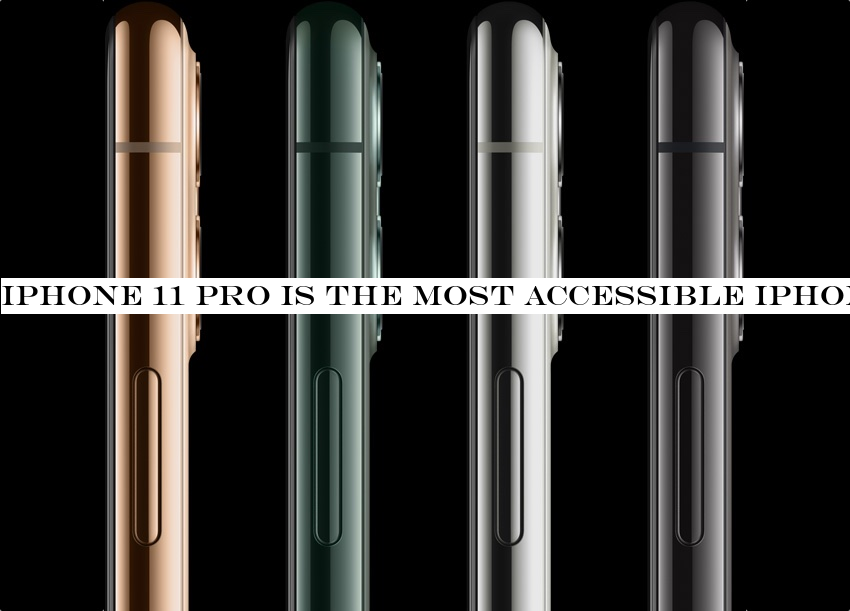
The Awesomeness of OLED
Apple provided me with two review units: one white iPhone 11 and one midnight green iPhone 11 Pro Max. As of this writing, I&ve had both phones for close to two weeks and I&ve spent roughly a week with each phone. I also have my year-old XR handy as a reference tool.
While I have spent lengthy time with OLED displays before—my iPhone X had one and, on a much smaller scale, every Apple Watch has had one—coming back after a year with my XRLiquid Retina LCD screen was quite literally eye-opening. Even with my poor eyesight, I immediately could notice a substantial difference in quality after putting my XR (and iPhone 11) side by side with the 11 Pro Max. For two years now, Apple has rightfully boasted about the XR(now 11) LCD screen being the best in the industry. It is ridiculously good, but the ProOLED display is itself so good that I&ve wondered during testing how I was able to live happily with my XR last year.
In practice, the Super Retina XDR display on the 11 Pro Max is appreciably better in all phases. In addition to being physically larger (albeit not by much), the 11 Pro Max displaybrightness and sharpness make everything I see on my device much easier. It reduces eye strain and fatigue, which are constant battles for me. iOS 13new dark mode looks fantastic on OLED screens; I have it set to automatically switch from light to dark at sundown, and use apps like Twitter and Things in their pitch black modes at nighttime. Although there are dark mode skeptics, I personally find it to be a welcome reprieve during evening hours, and the credit is due to the ProOLED display.
I started my testing with the iPhone 11 Pro Max for a few days, then switched to the regular 11 for another few days. After using both, knowing their respective screen technologies, I instantly knew which model I preferred. I could use the iPhone 11 with no problem, but having access to both phones reaffirmed to me just how superior OLED is for my vision. For my needs, itOLED or bust.
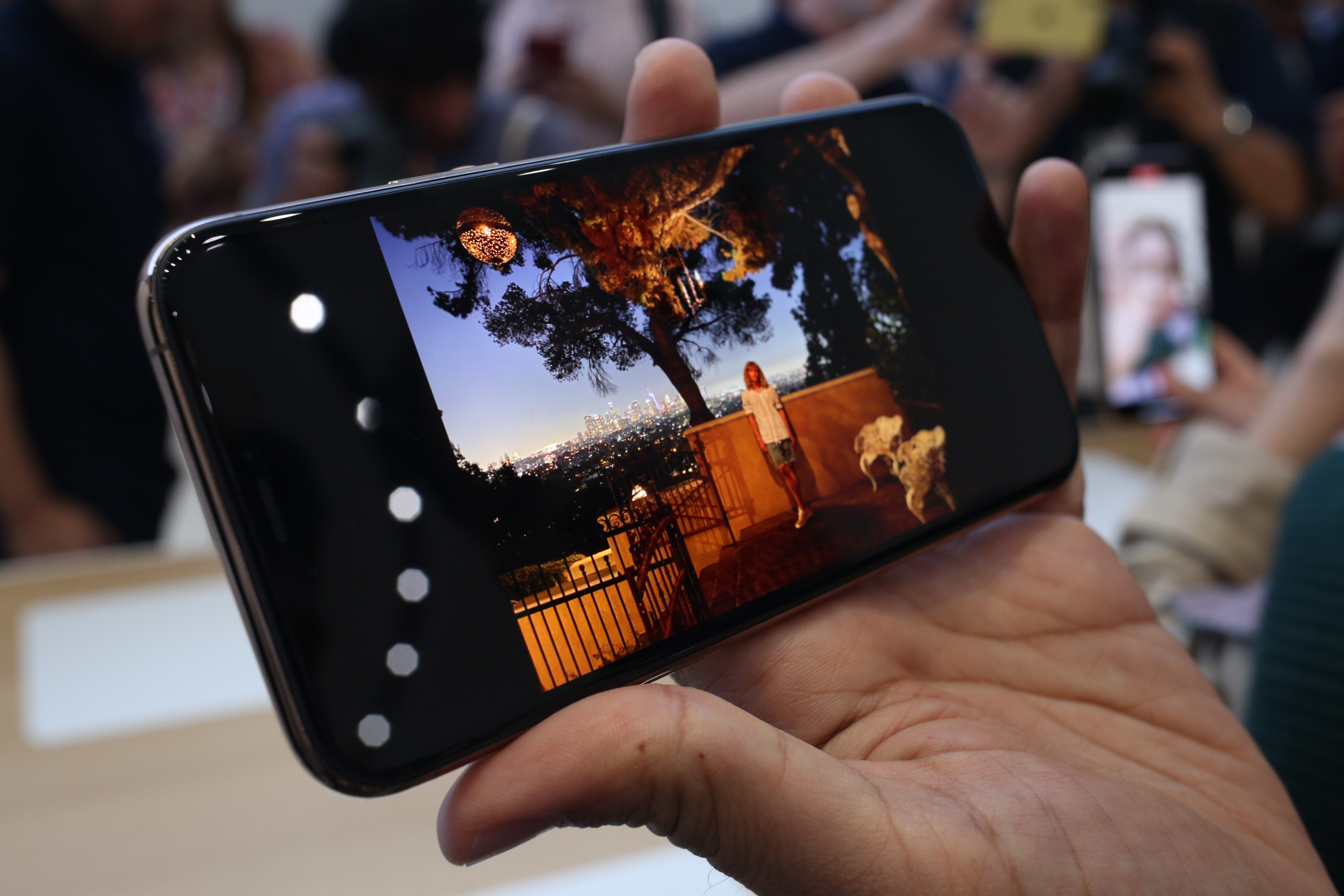
Three years with Face ID
I&ve written about my trials with Face ID before. As we collectively enter our third year with Applefacial recognition system, I think itworth briefly examining where it stands in context of the new iPhones and accessibility.
Apple says Face ID in the new iPhones is &up to 30 percent faster& while working from further away and at more angles than before. I cannot tell how much better it is in these regards; itFace ID and it seems to work just as well as it ever has. My strabismusstill seems to wreak havoc on the phones& TrueDepth camera system.
I set up Face ID on my 11 Pro Max and turned off Require Attention so that I needn&t look directly at the camera to unlock my phone. (When you do this, Apple blasts a modal alert on screen saying Face ID won&t be as secure as it could be. Fair enough, but ita trade-off I have to make in order to use it.) Itworked like a charm, as usual.
Whatinteresting, though, is what happened when I switched to the regular iPhone 11. I set up Face ID, but forgot to go into Settings and disable Require Attention. I suddenly realized this the other day, as I had clearly forgotten Face ID settings don&t sync from device to device. In hindsight itimpressive how much Face ID has seemingly improved at recognizing my gaze. Whether itpurposeful on Applepart, I don&t know, but I think ittelling that I was unlocking my phone and paying for Lyft rides pretty much hassle-free for days with Require Attention on by default.
My strabismus still makes me an edge case, so I prefer Require Attention be disabled, as itthe path of least resistance. Yet the happy accident I had regarding Require Attention led to a pleasant surprise. I can&t say itdirectly attributable to this generation of Face ID, but itan improvement regardless.
Adieu, 3D Touch
Like the much-maligned Touch Bar on the MacBook Pro, I have long been an ardent supporter of 3D Touch. I wrote about how it could positively impact accessibilitywhen in debuted with the iPhone 6s four years ago, and missed it with my XR.
Appleremoval of 3D Touch lends credence to the cons I outlined in my 2015 piece—namely, that it was too complex (for users and Apple) and it was too undiscoverable. The Apple community at large has felt this way about the feature since the beginning, especially bemoaning how it never percolated across iOS devices, most notably the iPad.
iOS 13 has brought Haptic Touch, first introduced with the iPhone XR last year, as a replacement for 3D Touch. Itmore or less equivalent; iOS 13 has expanded Haptic Touchscope so as to pick up many of 3D Touchtricks. These include Quick Actions on home screen icons and message previews in Mail and Messages. And importantly of course, these features work on iPads running iPadOS.
From an accessibility perspective, I have enjoyed having access to these shortcuts again on my iPhone 11 review units. I missed them during my time with the XR until now; the contextual menus throughout the OS really do cut down on excessive swiping and tapping. I like how Apple has grown Haptic Touch for the most part. I cannot tell an appreciable functional difference between it and 3D Touch in terms, say, starting a new email or text message from the home screen.
Where I believe Haptic Touch is a regression from 3D Touch is in performance. Accessing Quick Actions or link previews, for instance, feels like it takes forever relative to before. It isn&t so bad to the point that itunusable, but itdefinitely noticeable. More importantly, it causes Haptic Touch to lose a bit of the luster that makes haptic feedback such a promising assistive technology. Where 3D Touch always felt instantaneous, Haptic Touch, capable as it is, feels slower, thus ruining the fun a little. I assume this latency can and will improve over time, but count me as one who misses 3D Touch in the new iPhones.
[gallery ids="1885238,1885228,1885236,1885214,1885218,1885223,1885222"]
Miscellany
A few cursory notes on the new iPhones worth mentioning.
SIM card swapping. This is an extremely first-world problem, because I am privileged in the sense I get to review new iPhones every year. But this is an accessibility matter! Every year I get a new iPhone (or multiple iPhones) for testing, I&m reminded just how inaccessible the act of swapping my SIM card can be. It is a test of my visual acuity and fine-motor skills, both of which are not strong suits of mine. Especially on the midnight green, where the finish is so dark on the sides I can hardly see where the SIM tray is, moving between three iPhones can be quite adventurous. (I remember the jet black iPhone 7 having the same issue in terms of finding the SIM tray.) I like that Apple provides users with the SIM tool; the SIM card dance isn&t their fault. Still, as a visually impaired reviewer, I felt compelled to share this bit of accessibility minutia.
Color. Speaking of color, I do like the new midnight green finish a lot. The CWArrow is my favorite television show, and the shade of green strikes me as the iPhone Oliver Queen would choose.
Battery life. One of the iPhone 11biggest selling points is the dramatically increased battery life. I&ve long compromised my battery—on an iPhone, iPad, or Apple Watch—because I need to run my devices with maximum screen brightness in order to see. That I can do so on iPhone 11 and still mostly benefit from the battery gains speaks volumes about Applebattery work. I can go a whole day, using my phone normally at max brightness, and not stress about conserving my battery or finding an outlet somewhere.
Portrait (pig?) Mode. Seriously, Portrait Mode on the new iPhones was made for pigs.
The bottom line
Ita testament to the &completeness& of last yeariPhone XR that I was so happy with it. Yes, it was beautifully blue, but it was also a damn good all-around iPhone. Apple describes the iPhone 11 as having &just the right amount of everything,& the iPhone for everyone, but that tagline could just as easily apply to the XR. Even today, the XR is a great phone if you can do without the second camera. The iPhone 11 is simply a better iPhone XR.
The iPhone 11 and 11 Pro are close enough, spec-wise, that if it the regular 11 came in blue, I might&ve been tempted to upgrade to that. Therea reason Apple offers iPhones in a rainbow of colors; the psychological impact color has on consumerism is a very real phenomena. Perhaps someday soon there will be a blue iPhone with a Super Retina OLED display. That said, while both iPhones are highly impressive, I&m happy with the Pro for the upgraded screen quality and three cameras. You really can&t go wrong with either iPhone 11, but for this year anyway, the return to OLED was the clincher for me.
- Details
- Category: Technology
Read more: iPhone 11 Pro is the most accessible iPhone yet
Write comment (91 Comments)Roku will produce lower-cost versions of its new Smart Soundbar and Wireless Subwoofer for Walmart under the retailerown onn brand, the company announced this morning. While Roku offers distinct versions of some of its streaming media players exclusively for retailers like Walmart and Best Buy, the company had briefly mentioned a larger deal with Walmart in its second-quarter financial report.
In addition to the Roku TVs and players sold at Walmart, Roku had said it would offer &several new Roku devices including audio products,& under the Walmart onn brand.
The new onn Roku audio devices for Walmart are an expansion of the line introduced last month.
In September, Roku debuted two new devices, including the Smart Soundbar and Wireless Subwoofer, both at $180 each. The idea was to complement the existing Roku wireless speakers, in the case of the subwoofer, or offer an alternative for those who didn&t own a Roku TV or didn&t have enough space to set up the wireless speakers, in the case of the soundbar.
The Walmart onn-branded Smart Soundbar and Wireless Subwoofer, meanwhile, will only cost $129 each.
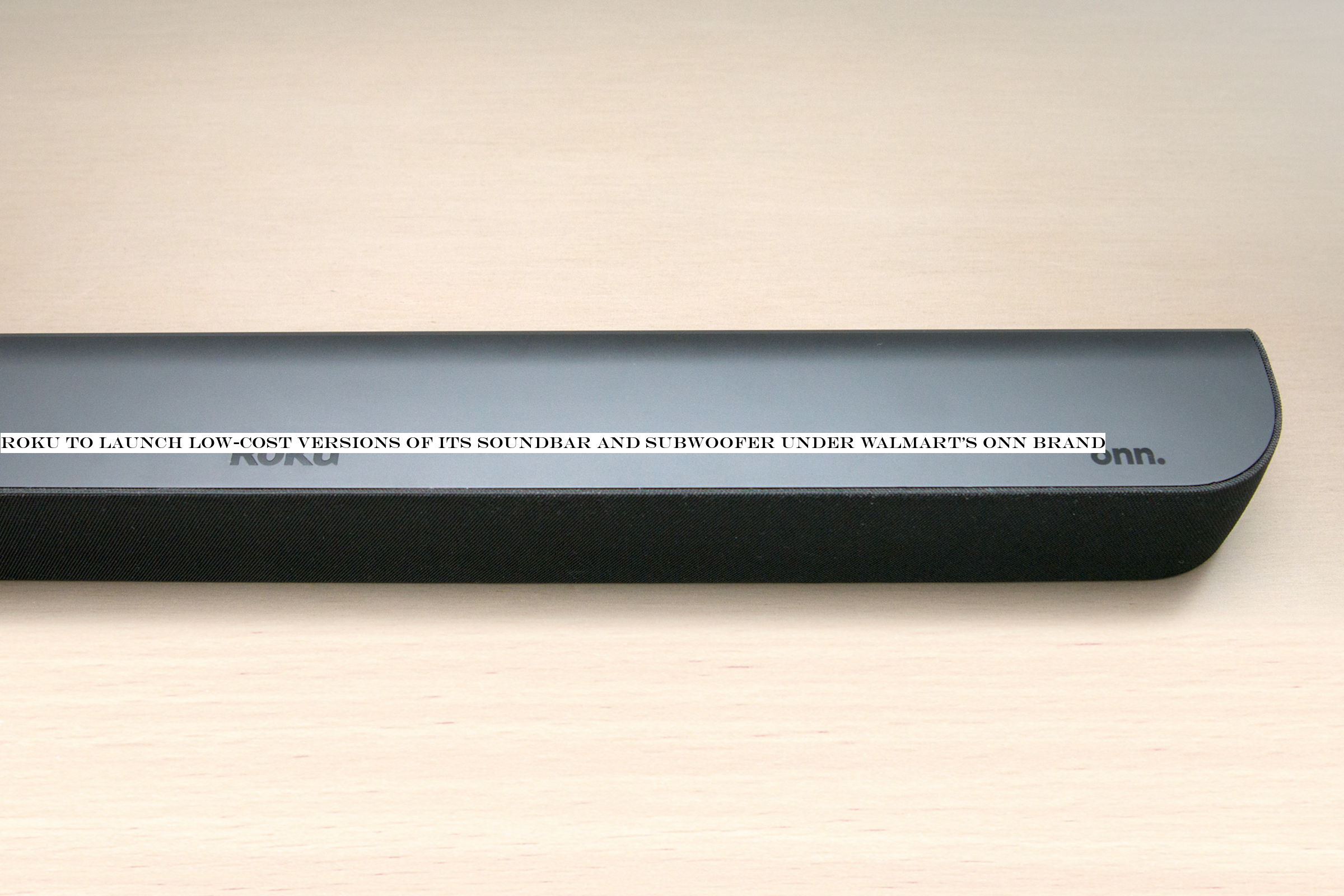
Similar to Rokuflagship models, onn Roku Smart Soundbar offers support for Dolby Audio, streaming from Bluetooth devices and connects to the TV via HDMI-ARC or HDMI and Optical. However, it will ship with Rokusimpler IR remote, offering TV power and channel button shortcuts instead of the more powerful voice remote that comes with the $180 version.
It also features 40W of peak power versus the Roku Smart Soundbar60W and different drivers.
The onn Roku Wireless Subwoofer is designed to work with the onn Roku Smart Soundbar to offer customers a deeper, richer bass. The lower-cost version features a 10″ driver like the Roku Wireless Subwoofer, but itslightly smaller and features 150 peak watts of power versus the Roku Wireless Subwoofer250 peak watts of power.
Both devices also feature branding and cosmetic differences, Roku says.
&Roku and Walmart have worked together for years to enhance the entertainment experience for millions of people who have purchased Roku TV models and Roku streaming players. Now, we&re looking forward to getting these new audio products on shelves to provide consumers with better sound for their TV experience at a great price,& said Mark Ely, vice president of Players and Whole Home Product Management at Roku, in a statement.

The Walmart exclusivity deal will help bring more customers to Rokuproducts at a time when the majority of Rokurevenue isn&t hardware sales, but rather platform revenue.
Led by advertising, Roku platform revenue has out-earned hardware sales for the past five quarters. And in Q2, Roku saw $250.1 million in revenue versus $224.4 million expected, up 59% from the same quarter in 2018 — the rise largely attributed to advertising.
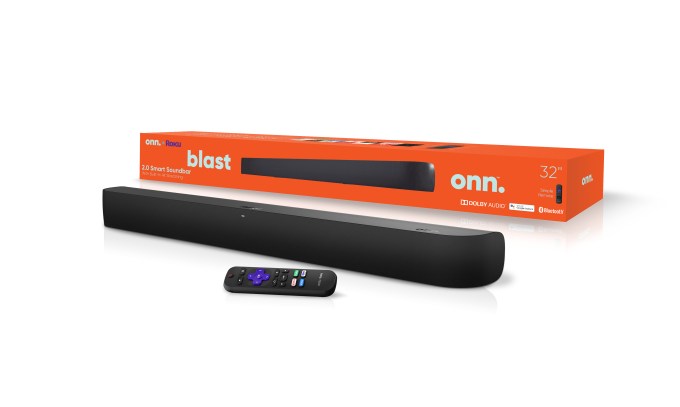
The new onn Roku-branded products may serve as an entry point for some customers into Rokuwider range of products, including its streaming players and Roku OS-powered TVs, for example. This, in turn, could help Roku grow its customer base for its platform business. In addition, Walmart shoppers are historically price-conscious, meaning they&re the ideal demographic to target with Rokugrowing ad-supported streaming business, where it provides free movies and TV through its home page hub, The Roku Channel.
The devices will become available sometime in the next few weeks both in Walmart stores and on Walmart.com, says Roku.
- Details
- Category: Technology
Read more: Roku to launch low-cost versions of its soundbar and subwoofer under Walmart’s onn brand
Write comment (99 Comments)Page 702 of 5614

 15
15





